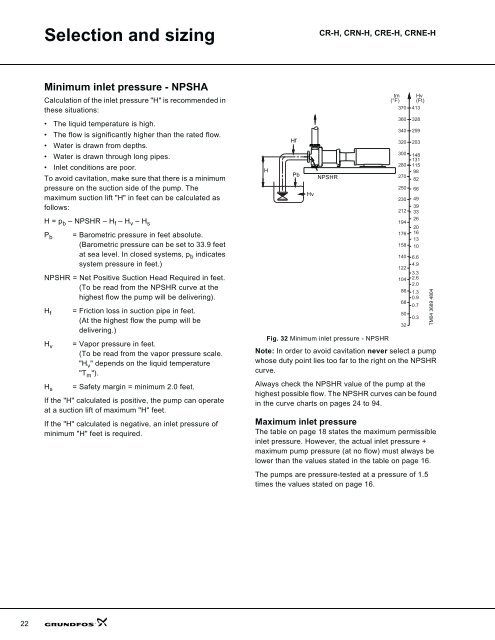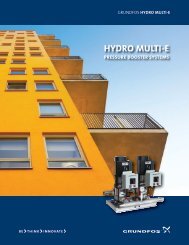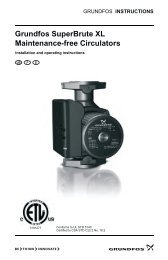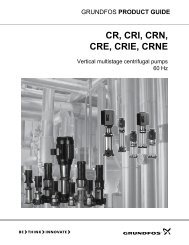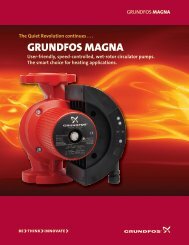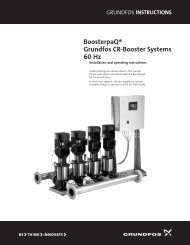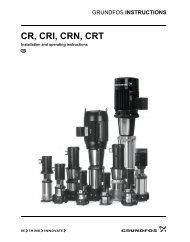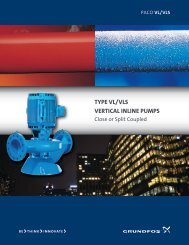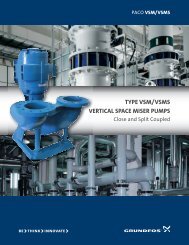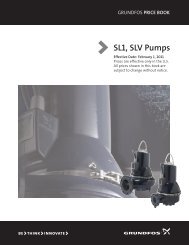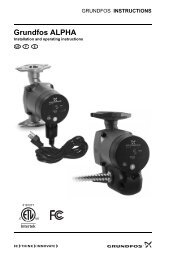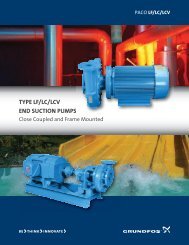product guide cr-h, crn-h, cre-h, crne-h
product guide cr-h, crn-h, cre-h, crne-h
product guide cr-h, crn-h, cre-h, crne-h
You also want an ePaper? Increase the reach of your titles
YUMPU automatically turns print PDFs into web optimized ePapers that Google loves.
Selection and sizing<br />
CR-H, CRN-H, CRE-H, CRNE-H<br />
Minimum inlet pressure - NPSHA<br />
Calculation of the inlet pressure "H" is recommended in<br />
these situations:<br />
• The liquid temperature is high.<br />
• The flow is significantly higher than the rated flow.<br />
• Water is drawn from depths.<br />
• Water is drawn through long pipes.<br />
• Inlet conditions are poor.<br />
To avoid cavitation, make sure that there is a minimum<br />
pressure on the suction side of the pump. The<br />
maximum suction lift "H" in feet can be calculated as<br />
follows:<br />
H = p b – NPSHR – H f – H v – H s<br />
P b = Barometric pressure in feet absolute.<br />
(Barometric pressure can be set to 33.9 feet<br />
at sea level. In closed systems, p b indicates<br />
system pressure in feet.)<br />
NPSHR = Net Positive Suction Head Required in feet.<br />
(To be read from the NPSHR curve at the<br />
highest flow the pump will be delivering).<br />
H f = Friction loss in suction pipe in feet.<br />
(At the highest flow the pump will be<br />
delivering.)<br />
H v = Vapor pressure in feet.<br />
(To be read from the vapor pressure scale.<br />
"H v " depends on the liquid temperature<br />
"T m ").<br />
H s = Safety margin = minimum 2.0 feet.<br />
If the "H" calculated is positive, the pump can operate<br />
at a suction lift of maximum "H" feet.<br />
If the "H" calculated is negative, an inlet pressure of<br />
minimum "H" feet is required.<br />
H<br />
Hf<br />
Pb<br />
Hv<br />
NPSHR<br />
Fig. 32 Minimum inlet pressure - NPSHR<br />
tm<br />
(°F)<br />
370<br />
Hv<br />
(Ft)<br />
413<br />
300 148<br />
131<br />
280 115<br />
98<br />
270<br />
82<br />
250 66<br />
230 49<br />
39<br />
212 33<br />
26<br />
194<br />
20<br />
176 16<br />
13<br />
158 10<br />
140 6.6<br />
4.9<br />
122<br />
3.3<br />
104 2.6<br />
2.0<br />
86 1.3<br />
0.9<br />
68<br />
0.7<br />
50<br />
0.3<br />
32<br />
Note: In order to avoid cavitation never select a pump<br />
whose duty point lies too far to the right on the NPSHR<br />
curve.<br />
Always check the NPSHR value of the pump at the<br />
highest possible flow. The NPSHR curves can be found<br />
in the curve charts on pages 24 to 94.<br />
Maximum inlet pressure<br />
The table on page 18 states the maximum permissible<br />
inlet pressure. However, the actual inlet pressure +<br />
maximum pump pressure (at no flow) must always be<br />
lower than the values stated in the table on page 16.<br />
The pumps are pressure-tested at a pressure of 1.5<br />
times the values stated on page 16.<br />
360<br />
340<br />
320<br />
328<br />
259<br />
203<br />
TM04 3689 4804<br />
22


